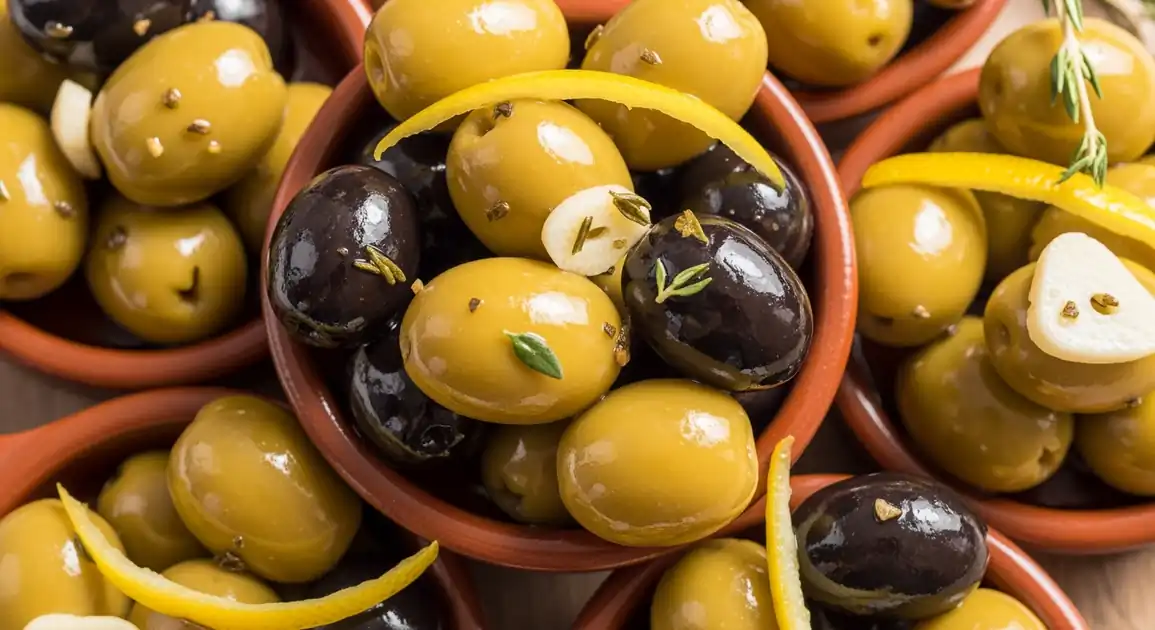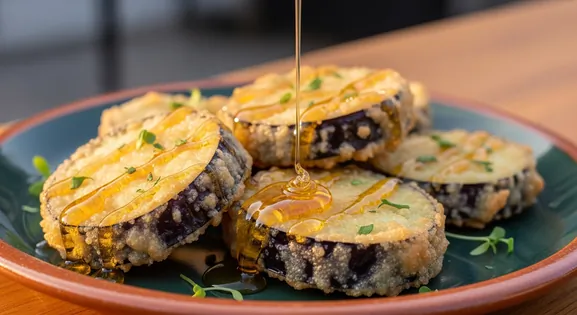Aceitunas Aliñadas (Marinated Olives) in Seville
Aceitunas Aliñadas

Discovering Authentic Aceitunas Aliñadas (Marinated Olives)
Stepping into a bustling Sevillano bar, the first thing you'll notice is the ubiquitous bowl of aceitunas aliñadas. These aren't just any olives; they're a vibrant, flavorful introduction to Seville's tapas culture, often served complimentary with your drink, embodying the city's generous spirit.
New to Aceitunas Aliñadas (Marinated Olives)? Learn all about its history in our complete guide.
Pro Tips for an Authentic Experience
For the most authentic and often complimentary aceitunas, venture beyond the main tourist areas into local neighborhood bars ('bares de barrio') in districts like Triana or Macarena.
While Gordal and Manzanilla are common, ask if they have 'aceitunas machacadas Sevillanas' (cracked Seville olives). These often have a more complex, garlicky, and herb-infused marinade unique to the city.
Elevate your olive experience by pairing them with a dry Fino or Manzanilla sherry, especially from Jerez or Sanlúcar de Barrameda. This classic Andalusian combination perfectly complements the olives' saltiness.
Quality Checklist: How to Find the Best
What to Look For
-
Busy tapas bars with high turnover
In Seville's popular tapas areas (like Santa Cruz, Triana), busy bars mean olives are consumed quickly and replenished often, ensuring freshness.
-
Olives stored covered or behind a counter
Look for bars where olives are protected from airborne contaminants and pests, especially in outdoor settings common in Seville.
-
Fresh-looking marinade ingredients (garlic, herbs)
The garlic, herbs, or peppers in the marinade should look fresh, not wilted or discolored, indicating recent preparation.
What to avoid
-
Uncovered bowls of olives on the bar counter accessible to everyone
Avoid communal bowls where hygiene standards might be low, especially in crowded Seville tapas bars. Prefer olives served individually.
-
Olives looking dull, shriveled, or swimming in murky brine
Indicates poor quality or old stock. Choose plump, vibrant olives in relatively clear marinade at Seville vendors.
-
Olives served in bars with generally poor cleanliness
If the bar area looks dirty, the food handling standards might also be low. Choose cleaner establishments in Seville.
The Art of Ordering
In Seville, olives are often a complimentary 'tapa' with your drink, especially in traditional bars. If not offered, simply ask for 'una tapa de aceitunas'. You can specify 'Gordal' for the large, meaty ones or 'Manzanilla' for smaller, crispier green olives. For a larger portion to share, ask for a 'ración'. Don't be afraid to try different 'aliños' (marinades) as each bar might have its unique blend of garlic, herbs, and spices.
Where to Find Aceitunas Aliñadas (Marinated Olives) in Seville
Triana
Famous neighborhood across the river, known for its traditional tapas bars and ceramics, great place for authentic olives.
Puente de Triana, Calle Betis, Mercado de Triana
Lunchtime, Evening
Santa Cruz
Historic Jewish quarter, touristy but has some hidden gem bars serving traditional tapas including olives.
Seville Cathedral, Alcázar, Narrow winding streets
Lunchtime, Evening
Alfalfa / Centro
This bustling central area is packed with traditional tapas bars and modern eateries, offering a wide selection of olives perfect for a mid-day snack or evening 'tapeo'.
Plaza de la Alfalfa, Plaza Nueva, Calle Sierpes
Lunchtime, Evening
Mercado de Triana / Mercado de Feria
Excellent markets with stalls selling high-quality local olives with various 'aliños'.
Mercado de Triana, Calle Feria (for Mercado de Feria)
Morning (for markets)
Vendor Tips
- Seek out bars favored by locals rather than just tourist traps for the best experience.
- Specifically ask for 'Gordal' olives to try the large, fleshy local variety.
- Mercado de Triana is great for seeing and buying a wide variety of local olives.
- Pair with a local Manzanilla sherry or a Cruzcampo beer.
Practical Details for Enjoying Aceitunas Aliñadas (Marinated Olives)
Dietary Information
Important Note for Travelers: Your safety is our priority. Below are the common allergens associated with the traditional preparation of this dish. However, recipes and ingredients can vary significantly between establishments. Always confirm all ingredients directly with the food vendor before ordering, especially if you have a severe allergy.
Potential Allergens
Dietary Suitability
Price Guide
Budget Tips
- Prices are generally very reasonable due to local abundance.
- Complimentary olives with a drink are still sometimes offered, though less guaranteed than in smaller towns.
- Markets like Mercado de Triana offer great value for buying olives by weight.
Serving & Seasonality
Served in small earthenware dishes ('cazuelitas'). Manzanilla and Gordal are the stars. Pits usually left in.Best Times to Enjoy
- Aperitivo Hour: Perfect snack with a cold beer ('caña') or sherry ('fino') before lunch (1 PM - 3 PM).
- Evening Tapas: Essential part of the evening tapas crawl ('tapeo') from 8 PM onwards.
Seasonal Availability
Available year-round, featuring locally harvested olives.
A Cultural Deep Dive
Local Significance
Olives are intrinsically linked to Seville and Andalusian identity. They represent the agricultural wealth of the region and the simple pleasures of its tapas culture.
Eating Customs
- Consumed casually at the bar counter or small tables.
- Sharing a 'ración' of olives among friends is common.
Unique Preparations of Aceitunas Aliñadas (Marinated Olives)
Aceitunas Gordal Aliñadas
The large 'Queen' olives marinated, often simply to highlight their size and meaty texture.
Aceitunas Manzanilla Aliñadas
The smaller, crisp green olives, typically with a more flavorful marinade.
Aceitunas Machacadas Sevillanas
Cracked green olives marinated in a traditional Seville style, often involving garlic, paprika, cumin, oregano, and sometimes bitter orange peel.
Aliños with Orange Peel
The use of local Seville orange peel in marinades adds a distinctive aromatic bitterness.
Step-by-Step Guides
How to Order Aceitunas Aliñadas in a Seville Tapas Bar
Learn the local etiquette for ordering and enjoying marinated olives, a quintessential Sevillano tapa, in any bustling bar or restaurant.
- Enter a Seville tapas bar (look for ones busy with locals, especially in areas like Santa Cruz, El Arenal, or Triana).
- Go to the bar counter. Olives ('aceitunas') are often displayed in bowls or listed on the menu/chalkboard.
- You can often just ask for 'una tapa de aceitunas' (a tapa of olives). They might have different types ('verdes', 'negras', 'aliñadas'). 'Aliñadas' implies marinated.
- Point to a specific type if displayed ('Quiero esas' - I want those). Common Seville types include 'manzanilla' (small green) and 'gordal' (large green).
- Olives are typically served as a small complimentary tapa with your first drink or as a very inexpensive paid tapa ('ración' for a larger portion). Enjoy with your 'cerveza' (beer) or 'vino' (wine).
Finding the Best Olive Varieties at Seville's Markets
Navigate Seville's vibrant food markets to discover and purchase the freshest local olive varieties and their unique marinades.
- Visit Mercado de Triana or Mercado de la Feria in the morning, when stalls are fully stocked.
- Look for vendors specializing in 'aceitunas' or 'encurtidos' (pickled goods).
- Ask to sample different 'aliños' (marinades) and olive types like 'Gordal' or 'Manzanilla'.
- Don't hesitate to ask for recommendations on which olives are best for snacking or taking home.
- Purchase by weight ('por peso') and enjoy the fresh, local flavors.
Our Commitment to Quality
At Tasteplorers, our mission is to provide the most accurate and useful travel information in the world. To achieve this, all content on this site is created through our unique editorial framework. We utilize leading AI research tools, guided by our proprietary prompts, and a multi-stage validation process. This entire system is overseen by our editorial team to ensure everything we publish meets our high standards for accuracy, cultural nuance, and practical value for travelers.
Learn more about our Editorial Process and our Mission.
Countries
Explore regions
Europe
Discover Europe's diverse culinary landscape, from Mediterranean flavors to hearty Alpine fare. Learn to navigate markets, decode menus, and eat like a local.
Latin America & Caribbean
Discover the vibrant cuisines of Latin America & the Caribbean. Our expert guide covers everything from Mexican street food to Peruvian ceviche and market tips.
Oceania
Explore Oceania's diverse food scene. Learn about Polynesian earth ovens, Fijian feasts, and the vibrant café culture of Australia and New Zealand.
Southeast Asia
Explore Southeast Asia's diverse food cultures from Thailand to Vietnam. Get expert tips on navigating spice levels, choosing quality vendors, and understanding the rich traditions of the region.

